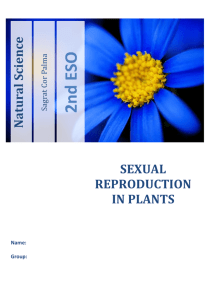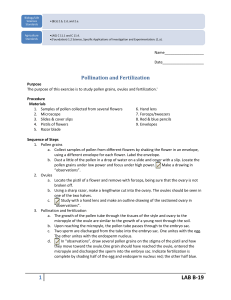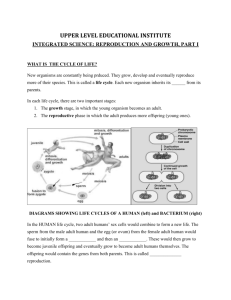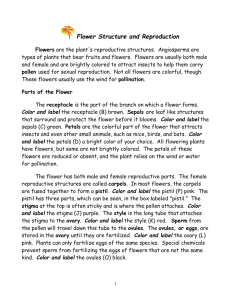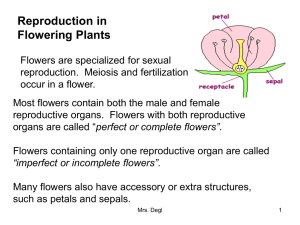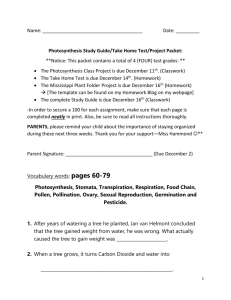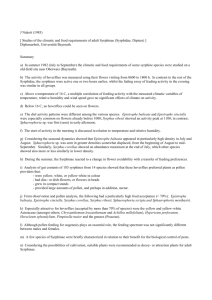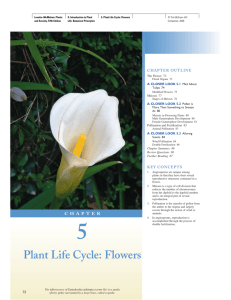Supplementary methods - Word file (33 KB )
advertisement
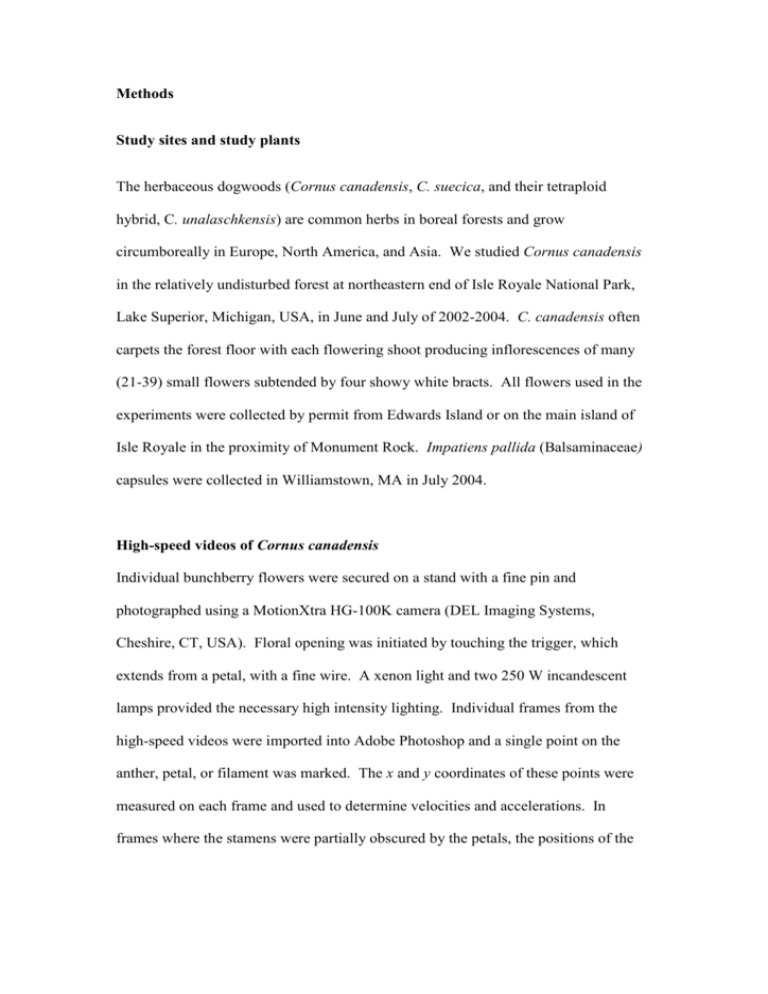
Methods Study sites and study plants The herbaceous dogwoods (Cornus canadensis, C. suecica, and their tetraploid hybrid, C. unalaschkensis) are common herbs in boreal forests and grow circumboreally in Europe, North America, and Asia. We studied Cornus canadensis in the relatively undisturbed forest at northeastern end of Isle Royale National Park, Lake Superior, Michigan, USA, in June and July of 2002-2004. C. canadensis often carpets the forest floor with each flowering shoot producing inflorescences of many (21-39) small flowers subtended by four showy white bracts. All flowers used in the experiments were collected by permit from Edwards Island or on the main island of Isle Royale in the proximity of Monument Rock. Impatiens pallida (Balsaminaceae) capsules were collected in Williamstown, MA in July 2004. High-speed videos of Cornus canadensis Individual bunchberry flowers were secured on a stand with a fine pin and photographed using a MotionXtra HG-100K camera (DEL Imaging Systems, Cheshire, CT, USA). Floral opening was initiated by touching the trigger, which extends from a petal, with a fine wire. A xenon light and two 250 W incandescent lamps provided the necessary high intensity lighting. Individual frames from the high-speed videos were imported into Adobe Photoshop and a single point on the anther, petal, or filament was marked. The x and y coordinates of these points were measured on each frame and used to determine velocities and accelerations. In frames where the stamens were partially obscured by the petals, the positions of the points were estimated by lining up an image of the whole stamen with the visible sections. The velocities were calculated from the change in position of the points in subsequent frames. The uncertainty in velocity, vi, was calculated to be the quadrature sum of position uncertainties, xi, divided by the time interval, T: v i 2 x i1 x i2 T . This procedure assumes that the position uncertainties are random errors that are not correlated and that the uncertainty in the time interval is small compared to the position uncertainty. Acceleration values, ai, and their uncertainties, ai, were obtained similarly from velocity data. Terminal velocity measurement Videos taken at 1,000 fps of exploding flowers were used to measure the terminal velocity of the pollen in air (supplementary movie 2). Successive vertical positions for 7 separate falling pollen grains were recorded from two different explosion events. The slope of the height of the pollen grain plotted as a function of time was used to determine terminal velocity. The number quoted is the mean velocity of all 7 grains and the uncertainty is the standard error of the mean. High-speed videos of Impatiens pallida To determine the time required for an Impatiens pallida (Balsaminaceae) capsule to explode open, we recorded fruit opening at 5,000 fps. We determined the time required for separation of the middle seed from the centre tissue of the capsule (3.25.4 ms) and the time required for the 5 outer sections of the capsule to separate from the central tissue of the capsule (2.8-5.8 ms) (n = 3). Sodium azide study To determine whether physiological processes are required for explosive flower opening, 13 closed flowers were incubated in the metabolic inhibitor 0.5% sodium azide1 for 3.5 h and then triggered; all opened fully. The viability of the filaments was tested using the vital stain flourescein diacetate, which fluoresces when cleaved by cytoplasmic esterases2. Following the sodium azide treatment, flowers were submerged for 10-15 min in a 1:1000 dilution of 1 mg/ml fluorescein diacetate stock, and then vigorously washed in three changes of distilled water. Individual filaments were removed and mounted on slides for observation under a fluorescence microscope using an FITC filter cube. Control (water-treated) filaments fluoresce strongly in a pattern that follows cell boundaries. None of the 24 azide-treated filaments examined showed bright fluorescence that followed the control cell pattern; 8 showed no fluorescence at all. Sucrose experiments To determine the effect of turgor on floral opening, mature flower buds were incubated for 4 h in solutions ranging from pure water to 2 M sucrose (0, 0.2, 0.4, 0.6, 0.8, 1, 1.2, and 2 M). Buds were then removed from the solutions, briefly blotted to remove large water drops, and triggered open. The angle that petals bend from vertical (n = 36) and the distance between opposing anthers (n = 9) was measured for each treatment. Both declined as a function of increasing sucrose concentration. For buds soaked in water, petals bent back a full 180 degrees, and anthers separated 3 mm. Incubation in 1.2 or 2 M sucrose resulted in petals moving less than 45 degrees and filaments separating by no more than 1 mm. Force measurements To measure the force required to open bunchberry flowers, we triggered flowers with a 0.13 mm diameter wire while recording from above with a 1,000 fps camera. Using the still frames we measured the maximum distance the wire was deflected beyond the stigma (centre of the flower). The deflection was converted to Newtons by using an electronic balance to measure the forces required to deflect the wire known distances. Pollinator Observations We observed pollinators visiting Cornus canadensis at Isle Royale National Park noting visitation rates and whether or not visitors were able to trigger open flowers. Samples of each insect type were collected and then weighed just after they were killed. Large insects, like bumblebees (~100mg) and long-horn beetles (~25mg), moved rapidly between inflorescences and regularly triggered open flowers. Small insects (<5mg), like ants and small syrphid flies, were unable to trigger open flowers and also were poor pollinators as they rarely moved between inflorescences. Pollen Movement Experiments To determine the distance pollen can be carried after an explosion, we measured the distance pollen traveled both indoors and outside. Indoors, we placed an individual flower in a small hole in the center of a 22 x 22 cm board covered with black plastic. The flower was then triggered open; pollen exploded from the flower was clearly visible on the black plastic. We measured the maximum distance pollen traveled from the center of the flower to the furthest visible pollen grain. Pollen from flowers exploded indoors traveled horizontally from 2.5 to 22 cm (mean = 8.8 cm, n = 7) with the distribution of pollen following the weak air currents present in the room. Outside we used a 1 x 1 m board covered with black plastic. In the presence of a steady wind, pollen was rapidly carried more than 1 m, exceeding our ability to measure it. Supplementary References 1. Vasilyeva, E. A., Minkov, I. B., Fitin, A. F. & Vinogradov, A. D. Kinetic mechanism of mitochondrial adenosine triphosphatase. Inhibition by azide and activation by sulphite. Biochem. J. 202, 15-23 (1982). 2. Rotman, B. & Papermaster, B. W. Membrane properties of living mammalian cells as studied by enzymatic hydrolysis of fluorogenic esters. Proc. Nat. Acad. Sci., 55, 134-141 (1966).



